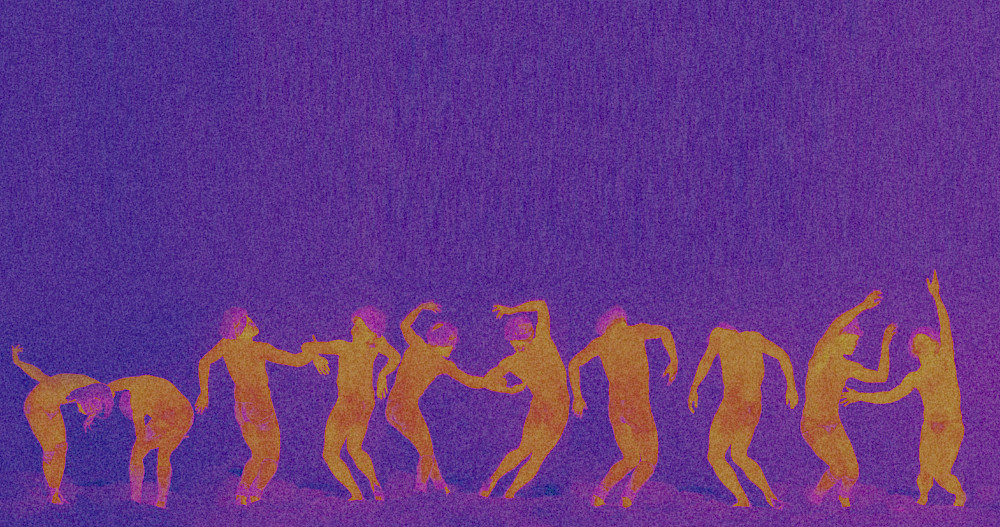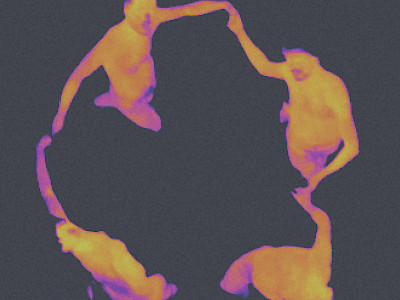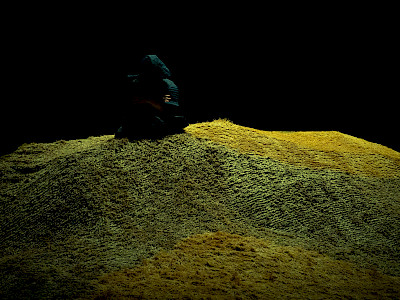07 — 09.05.2022
An immense green hill occupies the entire scene, the only fixed element in a constantly evolving choreography. For François Chaignaud, the starting point of his new creation is a recurring dream: imagining a community of singers and dancers who cross the boundaries between two disciplines. To achieve this, he joins forces with musical director Geoffroy Jourdain, who shares his interest in the sacred polyphonies of the Renaissance. On stage is a community of 13 individuals. They are either together or split into smaller entities, ready to contaminate each other and transport the melodic line. The idea of tradition comes alive: not fixed and not belonging to any individual, it instead passes through the bodies of those who welcome it. After the sublime experience of Symphonia Harmoniæ Cælestium Revelationum in 2019, Chaignaud returns to the festival with a repertoire that ranges from Antonio Lotti (17th century) to Claude Vivier’s Musik für das Ende (1971), with an impressive choreography in which, like the letters of the title, the bodies are separate and united at the same time. t u m u l u s is a fascinating masterpiece of voices and choreography that explores our paradoxical body, between the singular and the collective, between physicality and eternity.
Listen to the podcast "Symphonia Hildegardia", recorded with François Chaignaud during the festival in 2019, on Spotify, Soundcloud or Apple.
T U M U L U S
t u m u l u s is an endless procession of thirteen bodies singing and dancing within one and the same practice, one and the same gesture. The fruit of a unique collaboration between the choreographer Francois Chaignaud and Geoffroy Jourdain, director of Les Cris de Paris, this project carries the dream of jointly experiencing these two art forms, thinking about dance and music together.
Tumuli are mounds of earth that used to be raised over graves. A specific kind of burial place, these “works” contain the body of the dead as much as they do the life that comes after and grows above them. The research we did for this project lies at the heart of this paradox: a dead being still has life in it.
In the middle of the stage, a mound occupies the space. It’s covered in green, providing both a mausoleum and a landscape. It represents a volume on which the dancer-singers climb, hide and move around. The dance, a continuous procession of powerful, miserable, grotes-que and graceful figures, passes through the bodies like images unfurling on a bas-relief. To us it’s an ode to transition, flux and plasticity.
An essential part of our dramaturgy is linked to breath, the vector and sculptor of sounds, melodies and figures. The singing and gestures are experienced as constructions of air that create tension between what’s moving and what’s vanishing, what’s becoming petrified and what remains. Muscles, voices and diaphragms are the material of a tangible experience of permanent transition. In the emanation of air, we’re seeking to work on a perception of what is invisible and allows us to move.
Our musical repertoire comprises Franco-Flemish, Italian, English and German a capella polyphonic songs from different eras, from the Renaissance to the 1970s. Their sacred inspiration constitutes ways of experiencing collective emotions and progressions towards their transcendence. The music is experienced here not as a monument fixing bodies in ecstasy or deference, but as a wave going through us and connecting us with something continually transforming, decomposing and being reborn. It’s a vestige, a trace that moves between the performers. It’s a breeding ground of sensibilities and imaginary worlds for our voices, a vehicle for inventing new forms of relationship, care and attention.
The released breaths and continuous procession are rhythms that provide shapes, albeit fleeting, fragile and ephemeral ones. These make t u m u l u s the dream of a community of artists who share the joy of ageing and non-permanence since death. Together, they form a musical edifice that celebrates the absent through new movements that they allow our bodies to make.
- Baudouin Woehl, dramaturg
Songs
I. Jean Richafort (ca. 1480 — ca. 1547)
Graduale – Si ambulem
Requiem in memoriam Josquin Desprez
II. Claude Vivier (1948 — 1983)
Musik für das Ende
(Ed. Boosey & Hawkes, 1971)
III. Antonio Lotti (1677 — 1740)
Dies Irae*
Missa pro defunctis quatuor vocum
IV. Josquin Desprez (ca 1450 — 1521)
Qui habitat in adjutorio altissimi a 24*
(in Psalmorum selectorum [Johannes Petreius], Tomus 3, no 1, 1542)
V. William Byrd (ca 1540 — 1623)
Lullaby, my sweet little baby
(in Psalmes, Sonets & songs of sadnes and pietie, 1588)
*adaptations de Geoffroy Jourdain
Presentation: Kunstenfestivaldesarts, Kaaitheater
Conception: François Chaignaud, Geoffroy Jourdain | Choreography: François Chaignaud | Musical direction: Geoffroy Jourdain | With: Simon Bailly, Mario Barrantes, Florence Gengoul, Myriam Jarmache, Evann Loget-Raymond, Marie Picaut, Alan Picol, Antoine Roux-Briffaud, Vivien Simon, Maryfé Singy, Ryan Veillet, Aure Wachter, Daniel Wendler | Stage design: Mathieu Lorry Dupuy | Lights conception: Philippe Gladieuxa, Anthony Merlaud | Dramaturgy: Baudouin Woehl | Musical direction assistant: Louis Gal | Assistant choreography: Anna Chirescu | Costume design: Romain Brau | CNSMDP intern: Esteban Appesseche | Stage manager, lights: Anthony Merlaud or Marinette Buchy | Sound technicians: Aude Besnard, Camille Frachet, Alban Moraud, Jean-Louis Walfart | Technics: Laure Montagné or François Boulet | Dresser: Alejandra Garcia or Cara Ben Assayag | Stage manager TNS intern: Thomas Cany | Decor building: Ateliers de la maisondelaculture Bourges/Scène nationale | Costume production accomponied by Fusalp | Administration, production: Mandorle productions (Garance Roggero, Jeanne Lefèvre, Léa Le Pichon), Les Cris de Paris (Antoine Boucon, Diane Geoffroy, Aurore Lamotte) | International diffusion agency: A PROPIC (Line Rousseau, Marion Gauvent)
External production: Mandorle production, Les Cris de Paris | Coproduction: Kunstenfestivaldesarts, Bonlieu scène nationale, La Villette – Initiatives d’Artistes, Wiener Festwochen, Théâtre Vidy-Lausanne, Points Communs, scène nationale de Cergy-Pontoise, Théâtre de Saint-Quentin-en-Yvelines, TANDEM, Berliner Festspiele, Théâtre Auditorium Poitiers, Malraux scène nationale Chambéry Savoie, Opéra de Dijon, La Maison de la Danse de Lyon, Scène nationale d’Orléans, maisondelaculture de Bourges / Scène Nationale, Le Manège scène nationale – Reims, La Cité musicale-Metz, Ménagerie de Verre, Théâtre Molière > Sète scène nationale archipel de Thau, Théâtre de Cornouaille, Ballet national de Marseille – CCN, Scène Nationale du Sud-Aquitain, Festival d’Automne à Paris, Festival d’Avignon
Exceptional production support: DGCA | With the help of: Dance Reflections by Van Cleef & Arpels | Support: PEPS, Jeune Théâtre National, MC93 – maison de la culture de Seine-Saint-Denis, L’échangeur CDCN Hauts-de-France, Fondation Royaumont – Asnières-sur-Oise, CN D Centre national de la Danse – accueil en résidence, Le Regard du Cygne, Conservatoire National Supérieur de Musique et de Danse de Paris, soutien en résidence de création de la vie brève – Théâtre de l'Aquarium
Performances in Brussels with the support of the French Institute, the French Embassy in Belgium and The Alliance Française, in the frame of EXTRA (2022)






